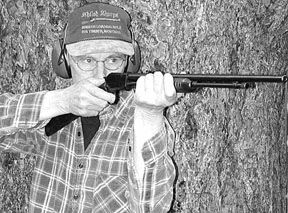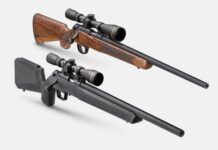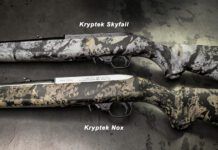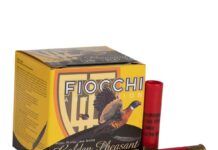
Pump-action .22 rifles have been with us for well over a century. Many millions of kids cut their shooting teeth with a pump rifle, a supply of tin cans, and Dad’s careful tutoring. Shooting galleries throughout the U.S., and probably the world, used the Gallery model of the Winchester, so many people gained familiarity with the rifle even if they never owned one. Pump-rifle designs were generally simple and durable, and the Winchesters probably set the standard for other makers to follow.
The common talk among shooters was that you could load the .22 pump rifle in the morning and shoot it all day, or something like that. Whether or not the Winchester Model 62 was the first rifle that spawned that phrase (it was probably the Winchester Model 1890), the 62 would fill the bill with its full-length tubular magazine that accepted 20 Short, 16 Long, or 14 Long Rifle cartridges. Per the 10th Edition of Modern Gun Values, the Winchester Model 62 rifle was introduced in 1932 and discontinued in 1959. That tome gives an approximate value for the Model 62 Winchester in excellent condition at about $600, but that price has probably gone up since our 1996 edition was printed. We were lucky enough to obtain the loan of a Winchester 62A in excellent condition, which gave us an excellent basis for comparison with two new pump .22s we also acquired, a close copy of the Model 62 Winchester by Taurus, called the M62 Carbine ($279) with 16.5-inch barrel, and another by Henry Arms, called simply the Pump Action .22 ($300), with an extended forend and side ejection.
We put these to our functional and accuracy tests, beginning with the Winchester to see what a good, classic pump gun would feel like. First, we shot them offhand to get a feel for what they offered. Without spoiling the story, we liked what we found from this informal shooting. All three balanced well, and all three had acceptable triggers. We were shooting at a stump at 75 yards, so didn’t try for accuracy until later, off the bench. But all fed and functioned well right off the bat. In fact, there were no failures to feed or function with .22 LR ammo in any of the three rifles throughout our shooting. Here are our formal findings.
[PDFCAP(1)]
This discontinued rifle had seen only limited use. It had to be at least 44 years old, but looked like it had left the factory only a few years ago. All the parts fit beautifully, but the stock finish had some visible longitudinal scratch marks in the wood that extended into the hard-rubber butt plate. These were original sanding marks from factory finishing, because the gun had not been refinished. This less-than-perfect stock finish was typical for many early Winchester .22s, per one of our sources, who told us if the wood had been rubbed with linseed oil over the years, per the factory’s recommendations long ago, it might look even better now. The walnut of the butt stock had some distinct character, as did the finger-grooved forend, but the two pieces of wood didn’t match for grain and color. The forend had sharp-edged grooves with little or no signs of wear, and no cracks. There was no checkering on the straight-gripped butt stock. The forend wood was nicely rounded at the front, and the rear edge was gently rounded for comfort and aesthetics.
The bluing was outstanding, both for quality of polish and application. The metal had no dishing or any other obvious buffing marks. The sides of the action were flat, and where they met the tops and bottom of the action there was a clean, straight edge. This was a take-down model. Our sources didn’t indicate if they all were, or not. The later 1890 Winchesters were all take-downs, so we guess the Model 62 was also. (Taurus’s copy was a take-down as well.) Removing a thumb-screw on the left side of the action permitted the two parts to be separated for ease of carrying or storage. The screw stayed with the rifle so could not become lost.
The Winchester’s sights were a flat-top, U-notch rear and a bead front, both dovetailed into the barrel. The rear sight had an extension base that was actually a spring, with a stepped wedge for elevation. The hammer was serrated for easy cocking. There was a half-cock notch for safety, and no other safety devices. The trigger was smooth-faced and broke cleanly at 3.5 pounds. The rifle was all steel and walnut except for the butt plate, so far as we could see. Workmanship, fitting and inletting were generally outstanding throughout.
The identification marks on the barrel were bright and clean, with no signs of rework or wear. In addition to the factory name, address and the caliber designation (Shorts, Longs, and Long Rifles), the barrel contained the Winchester proof mark, as did the front of the action,
We knew the old Winchester performed well enough from offhand, so it was time for serious bench-rested evaluation. We shot from 50 yards using the iron sights that came with each rifle, and used our heavy machine rest. We shot with Federal Classic high-speed, Remington high-speed, and some Eley Tenex match fodder, the latter just to say we’d given the pump guns every chance to shoot well.
[PDFCAP(2)]There were zero functioning problems, as already mentioned, but we were a bit disappointed with the accuracy we got out of the Winchester. Our best group of 1.8 inches at 50 yards was obtained with Federal Classic ammunition. The Eley match fodder didn’t beat that even on average. During our bench shooting we distinctly noticed the Winchester’s action was a whole lot slicker than that of either of the other two guns. We suspect the latter two will smooth up with use, but it may take some effort to get them as smooth as this Winchester. Our only complaint about the Winchester was that we had trouble, as usual, keeping constant elevation with the bead front sight. We don’t believe it hurt accuracy much, but we sure thought we’d get better groups out of this old rifle. The barrel was pristine, as was the crown. One accuracy problem may lie with the loose forend of typical pump guns, which can’t help but rattle as the bullet travels down the bore. Yet ours was cradled within the shot-filled leather confines of our machine rest and didn’t appear to be able to move much. This old rifle felt very comfortable, and we enjoyed our shooting experience with it very much. It kind of took us back a few years.
One strong warning about both the Winchester and Taurus rifles: If you hold the trigger back while working the action, the rifles WILL fire as soon as the round goes home. Be sure to remove your finger from the trigger before working the action. Although the Henry did not have this potential trouble and we could not make it fire, its hammer would follow the bolt down, so take your finger off the trigger between shots for safest handling.
[PDFCAP(3)]
A take-down, like the Winchester it copies, the Brazilian-made Taurus was a good deal smaller than the Winchester, due mostly to barrel length. Several options, including full-length 23-inch barrel and stainless-steel versions of this rifle, are available from Taurus, and there are also casehardened-action models, according to one source. The barrel was marked to indicate the caliber as .22 LR, with no mention of Shorts or Longs. The overall design was very similar to that of the Winchester, and they had similar sighting equipment and stock configurations. The walnut-looking wood of the Taurus had significant character, and had a decent, oil-like, red-tinted finish on butt stock and forend. The underside of the Taurus’s forend, however, was sliced longitudinally through the finger grooves underneath, leaving what we thought was an ugly, flat portion on the forend. However, one source indicates some Winchesters also had a flattened forend. Our test Winchester had a rounded forend that looked great. Also, the Taurus’s grip shape was not quite right, in that it got thinner as it went rearward, as seen from the side. The Winchester’s stock at the grip had parallel top and bottom surfaces. One additional slight problem with the Taurus was the rear edge of the wood forend, which was needlessly sharp. It needed to be eased by rounding or chamfering, we felt.
The addition of a safety on the Taurus did exactly nothing for its looks. Located smack-dab on top of the action was an L-shaped lever that rotated through 90 degrees to block the firing pin. There was a red F to indicate firing position, and the detents worked well enough, but this safety seemed out of place on such a simple firearm, we thought. While the Taurus had the same half-cock notch as the Winchester, the real safety was to leave the chamber empty and the hammer down until ready to shoot. The add-on safety did have one function in that it made it easier to lower the hammer if you didn’t want to take a shot, once the chamber was loaded and the hammer cocked. With all three rifles there was no way to unload the chamber without rechambering another round, unless you were to loosen the magazine follower and hold the muzzle pointed downward while unloading the chamber with the pump motion. There was another safety on the Taurus, a lock on the hammer operated by a little key. When the key is turned, the hammer can’t be cocked nor the bolt operated. All the operations of the rifle are thus locked. Be sure you don’t lose that key.
The overall workmanship was excellent. Inletting left no gaps, metal polish and bluing were very well done, and the stock finish was about as good as on the Winchester. There was a slight burr on the action-activating rod, which ran from the forend into the action, and its sharp edge could have caused cuts. The takedown mechanism worked well, and the innards looked just fine. The hammer was well serrated for good control. There was no plastic visible except on the butt plate, where it belonged. The fit of this plate was outstanding, and its backside gave good traction on our shoulders. At 4.7 pounds, this little rifle was a joy to handle. Static balance was just behind the front of the action, where the carrying hand naturally went.
The Taurus’s sights were a U-notch rear (spring-style) with an easily seen post front. The sight picture and under-three-pound trigger led us to expect good things from the bench-rest session. Alas, they were not to be, and we don’t know why not. Our best group was 2.6 inches with the Eley match ammo, and the worst was a pathetic 7.7 inches with Remington’s high-speed ammo. We gave it every chance with the Eley Tenex ammo, even wire-brushing the bore between strings, but all to no avail. We hope this is not typical of this well-made and attractive little rifle. This rifle was intended for Long Rifle ammunition only.
[PDFCAP(4)]
The Henry Pump, according to the company’s website (www.henryrepeating.com), handles Shorts and Longs as well as Long Rifle fodder. The rifle had side ejection instead of the top-ejection of the Winchester and Taurus tested above. Would this help accuracy? Small groups had not been a strong point with either of the pump rifles tested so far. We’ll find out soon, but first let’s take a close look at the Henry.
The first thing we noticed was the stock finish, which was well done, but it tended to hide the quality of the gun’s nicely shaped black walnut. While this was the best applied finish, and seemed to be the most durable, of all three rifles, it gave a milky cast to the wood, compared with the finish of the other two rifles. (The others responded well to a light rub with artist’s-quality linseed oil.) Yet we feel sure this finish will hide or shrug off many nicks and dings. There was no checkering, but the forend was grooved for easier operation.
The receiver was not steel. It did have a good polish job, and the shiny-black metal finish matched the blued and highly polished steel of the barrel well. The front sight had a dust cover, but we’re not sure how long it’ll last because there didn’t appear to be any detent to hold it in place. With our limited shooting, the cover came more than halfway off toward the front. We could easily slide it backward and forward with light thumb pressure. Epoxy might be a suitable fix.
The front sight itself was a flat-top post, but it had a distinct tilt to the left as seen through the square-notch rear sight. The front sight and its ramp were actually plastic, being extensions of the forward band that tied the magazine tube to the barrel. A single screw behind the front blade held it all together. A second plastic band helped tie the two tubes together, this one located just in front of the forend, and secured by a steel pin that caught the bottom of the barrel. The rear sight was a well made and well formed traditional spring affair with stepped insert, the whole affixed into a dovetail in the barrel.
The forend wood extended rearward to cover the front portion of the receiver, and also protected the operating arm. When working the action, the forend moved a shorter distance than the bolt, which gave the rifle a crisp action but one requiring a firm and stout tug on the pump to achieve. The top of the receiver was grooved for conventional scope mounting. Ejection was to the right through a carefully made and snag-free port. The bolt extended out the back of the action to cock the hammer, and reminded us of the overall look of a Marlin lever gun at that point. Inletting was very good, as was overall workmanship. The wood was not quite plain walnut, and the forend matched the butt well. The butt plate was black plastic, well checkered, and comfortable.
The hammer had sharp serrations for control, and was easily cocked or lowered. A small, rounded, serrated button under the action and just in front of the trigger guard permitted opening the cocked action whenever the shooter desired. However, the design did not permit closing the action without chambering another round. There was no safety on this rifle other than the half-cock notch.
Overall it was a very attractive rifle, we thought, and we had yet to shoot it. Balance was great, too, though this rifle was a touch heavier than its test mates. The trigger pull was 4.5 pounds with some creep. At the range, we found we had a shooter in the Henry. Our best group was totally round, and measured 1.4 inches, made with Federal’s Classic high-speed fodder. All groups averaged less than two inches, making this the best shooter by far of the test. So what if it has some plastic. It shoots! Our respect for the little rifle went up about five miles once we saw how well a pump-action .22 rifle could perform. A bit of work on the trigger might be in order, but it also might smooth out with time. We thought this rifle didn’t really need a trigger job.
We did try both the Henry and the Winchester with Shorts and Longs, and while the Winchester performed faultlessly with both types in our brief tests, the Henry jammed many times (failed to eject) with Shorts. The Longs seemed to work well, and there were no problems at all with Long Rifles.
Gun Tests Recommends
Winchester Model 62A, about $600, Buy It. If you can find one of these old Winchesters in good shape for a good price, we believe you’ll be rewarded with pride of ownership and solidly increasing value over the years. The rifle was well made, and if our test piece was any indication, the Model 62 was built to keep on shooting for a long time. In addition to being a well-made rifle and a sound investment, the Winchester can also be a happy link to earlier times, when minute-of-tin-can was a good enough measure of accuracy for the prime intent of this classic pump-action rifle.
Taurus Model 62, $279. Conditional Buy. We liked the look of this carbine and the quality of its workmanship, but would like to know a lot more about why this one won’t shoot before we’d personally own a copy of it. However, poor accuracy in one sample didn’t cause us to reject this gun totally. There was some promising shot clumping during our tests, telling us the gun was trying to shoot. There may be a slight flaw that’s causing problems with our sample. We would be tempted to buy it even with its poor accuracy because of the promise it held, and because it was so handy. Though we were anything but happy about its accuracy, we liked this little rifle. We saw prices on the Internet as low as $200 for this gun in like-new condition. For that kind of price, you can do a lot of messing with accuracy to (hopefully) turn one of these into a much more accurate and useful rifle, and if that could be accomplished, it’d be a real bargain at that price.
Henry Repeating Arms Pump Action .22, $300. Our Pick. If we owned this Henry pump we’d secure the front-sight hood in some manner, and shoot the dickens out of it. It’s that kind of rifle. Because it was such a fine performer, we’d pick it over the other rifles, yes even the Winchester, because we firmly believe the purpose of shooting is hitting. It would be a simple matter to scope the Henry if desired. That would be difficult with the others, though iron sights are surely part of their charm. No matter what kind of sights you use with the Henry Pump, there are no excuses if you miss yonder tin can.




























